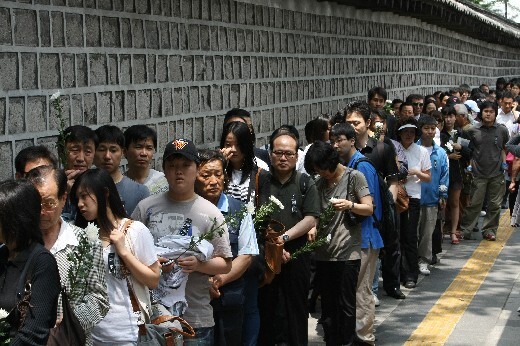hankyoreh
Links to other country sites 다른 나라 사이트 링크
Police and citizens conflict over Roh’s memorial

Anger from citizens on Sunday was as great as the mass of white flowers that had been placed at a spontaneous memorial for the late President Roh Moo-hyun that emerged in front of Deoksugung Palace’s Daehanmun Gate. Police placed a double line of police vehicles between the surrounding streets and walkways in order to control passage. As the line of mourners grew longer, citizens began raising their voices, asking whether the police were going too far in blocking acts of mourning.
Police used some 60 vehicles as barriers in front of Daehanmun Gate where the memorial had been established and between Seoul Plaza and Cheonggye Plaza to control citizen access. Police placed a double line of some 20 riot police buses in between the walkway and road in front of Daehanmun Gate, completely blocking the memorial from outside view. The plaza in front of City Hall was completely surrounded by buses and not even one blade of grass was visible. Im Won-sik, 28 years old, said he had heard of a memorial near City Hall and came to pay his respects on Sunday, but because the memorial was completely blocked by police vehicles, he did not know where it was. He wondered whether people could properly memorialize the president under these conditions.
With police controlling passage into the area surrounding the memorial, the procession of mourners grew abnormally as time passed. According to a police estimate, a line of 4,000 mourners went from the memorial in front of Daehanmun Gate past the stonewall of Deoksugung Palace and around 150 meters towards Gwanghwamun as of 5:00 p.m. Sunday. Due to the police presence, the line snaked back another 50 meters in the direction of the memorial, went underground through Exit 3 of the City Hall subway station, circled around the ticket booth, and came back up through Exit 4 from the Korean Press Center and back towards City Hall. The length of the line was over 1 km. Police blocked off City Hall’s side of Exit 5.
A Mr. Mun, 51 years of age and who came from Seoul’s Sillim-dong in Gwanak-gu to visit the memorial, said it took around 30 minutes just to find the end of the line after exiting the City Hall subway station. He referred to the police blockade of the memorial procession as wretched. Ms. Kim Jeong-ae, 41 years of age and who waited over two hours to place flowers before Roh’s memorial portrait, criticized the government for not providing a decent memorial space in Seoul and for blocking the citizens’ spontaneous memorial.
A Mr. Jo, age 38, said police helped citizens mourn when Cardinal Stephen Kim Sou-hwan passed away, but were setting up walls of police vehicles in this instance. He asked if this was the proper way to pay respects to a former president.
Since Saturday, the online bulletin board of the National Police Agency has been flooded with hundreds of posts criticizing the behavior of police, asking police whom they worked for and pleading that they not block mourners or Roh’s “final path.” A police official noted that an average mourner would return home after paying respects, and asked why people were staying in front of Daehanmun Gate. He said police had set up a blockade because people who were intent on holding an unregistered demonstration were gathering. The police deployed 12 companies or a total of 960 men in front of the Daehanmun Gate alone. Throughout the entirety of Seoul, they deployed 104 companies or 8,320 men.
Shin Kwang-Yeong, a sociology professor at Chung-Ang University said the government’s blocking of the citizens’ free cultural and memorial activities based on the arbitrary presumption that a demonstration could develop was a violation of the constitutional right of the freedom of association. Others further suggest that this blockade shows that police power is not being based on proper judgments or to protect public safety, but instead is being used politically.
Please direct questions or comments to [englishhani@hani.co.kr]
Editorial・opinion
![[Editorial] Does Yoon think the Korean public is wrong? [Editorial] Does Yoon think the Korean public is wrong?](https://flexible.img.hani.co.kr/flexible/normal/500/300/imgdb/original/2024/0417/8517133419684774.jpg) [Editorial] Does Yoon think the Korean public is wrong?
[Editorial] Does Yoon think the Korean public is wrong?![[Editorial] As it bolsters its alliance with US, Japan must be accountable for past [Editorial] As it bolsters its alliance with US, Japan must be accountable for past](https://flexible.img.hani.co.kr/flexible/normal/500/300/imgdb/original/2024/0417/6817133413968321.jpg) [Editorial] As it bolsters its alliance with US, Japan must be accountable for past
[Editorial] As it bolsters its alliance with US, Japan must be accountable for past- [Guest essay] Amending the Constitution is Yoon’s key to leaving office in public’s good graces
- [Editorial] 10 years on, lessons of Sewol tragedy must never be forgotten
- [Column] A death blow to Korea’s prosecutor politics
- [Correspondent’s column] The US and the end of Japanese pacifism
- [Guest essay] How Korea turned its trainee doctors into monsters
- [Guest essay] As someone who helped forge Seoul-Moscow ties, their status today troubles me
- [Editorial] Koreans sent a loud and clear message to Yoon
- [Column] In Korea’s midterm elections, it’s time for accountability
Most viewed articles
- 1[Column] The clock is ticking for Korea’s first lady
- 2[Editorial] When the choice is kids or career, Korea will never overcome birth rate woes
- 3[Guest essay] How Korea turned its trainee doctors into monsters
- 4[Editorial] As it bolsters its alliance with US, Japan must be accountable for past
- 5S. Korea, Japan reaffirm commitment to strengthening trilateral ties with US
- 6Korea, Japan jointly vow response to FX volatility as currencies tumble
- 7Gangnam murderer says he killed “because women have always ignored me”
- 8Japan officially says compensation of Korean forced laborers isn’t its responsibility
- 9[News analysis] After elections, prosecutorial reform will likely make legislative agenda
- 10‘Right direction’: After judgment day from voters, Yoon shrugs off calls for change